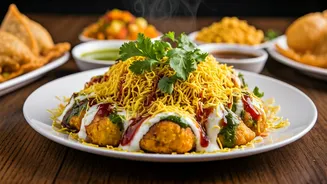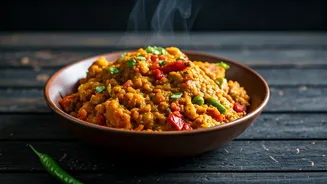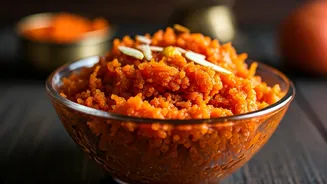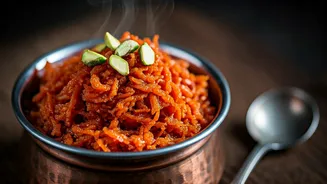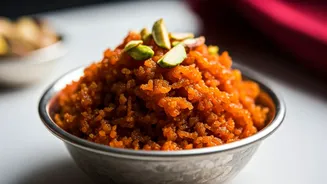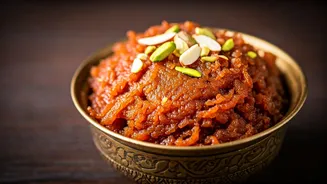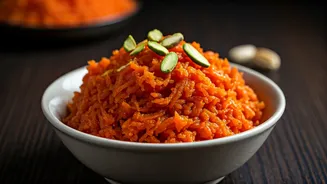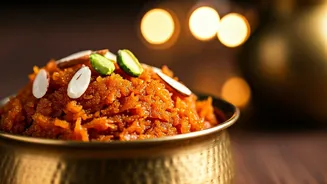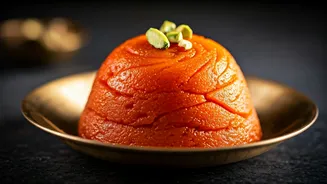Halwa's Humble Beginnings
Gajar ka halwa, a cherished dessert in India, boasts a delightful blend of grated carrots, milk, sugar, and ghee. Its origins are deeply rooted in the
Indian subcontinent, where it has evolved over centuries. Traditionally, the process involved slow cooking, ensuring a rich and intensely flavored dessert. However, this method demanded significant time and effort. Modern adaptations focus on reducing preparation time without sacrificing the essential flavors. This recipe modernizes the traditional approach, enabling a quick and easy preparation that honors the spirit of the original dessert.
Gather Your Ingredients
To begin, collect the essentials. You will need grated carrots, preferably finely grated for speedier cooking. Milk or, for added richness, full-fat milk is recommended. Sugar, which sweetens the halwa, is another core ingredient. Ghee is crucial for its distinct flavor and aroma, helping the carrots caramelize and adding depth. Cardamom powder, often added for a touch of fragrance, is optional but recommended. Finally, a sprinkle of nuts, such as almonds or cashews, offer a satisfying crunch and visual appeal. Make sure all ingredients are measured and ready before you start cooking, as this streamlined method works best when you're prepared.
The Swift Cooking Process
Heat the ghee in a heavy-bottomed pan or a non-stick skillet over medium heat. Add the grated carrots and sauté them for about 2-3 minutes, ensuring they soften slightly and absorb the ghee. Pour in the milk and sugar, then stir continuously to prevent sticking. Allow the mixture to simmer, stirring frequently, until the milk has nearly evaporated and the carrots have softened. This stage usually takes around 5-7 minutes. If desired, incorporate cardamom powder for an aromatic twist. Finally, garnish with chopped nuts and serve hot. The entire process takes approximately 10 minutes, offering a convenient way to enjoy homemade gajar ka halwa.
Tips for Perfection
For an even quicker result, microwave the carrots with a bit of ghee before mixing them into the milk and sugar mixture; this can reduce cooking time. Do not overcrowd the pan; cooking in batches ensures even caramelization and prevents the halwa from becoming watery. If you prefer a richer, creamier halwa, consider using condensed milk in place of some of the sugar. Continuously stir the halwa during the simmering process to prevent burning and ensure a uniform consistency. When garnishing, toast the nuts lightly in a separate pan for a richer flavor. These subtle adjustments enhance the taste and shorten the cooking period.
Serving Suggestions
Gajar ka halwa is best enjoyed warm. It makes an excellent dessert for festive occasions and is equally appealing as a satisfying after-meal treat. Consider serving it with a dollop of fresh cream or a scoop of vanilla ice cream for extra richness. For a variation, incorporate a handful of raisins or sultanas during the cooking phase. Leftover halwa can be stored in the refrigerator for up to 2-3 days and can be reheated in a microwave or on the stovetop. It also pairs well with savory dishes, serving as a sweet contrast to a hearty meal. Experiment with various presentation styles and garnishes to enhance the appeal.
Enjoy Your Halwa
With this 10-minute recipe, you can experience the pleasure of gajar ka halwa anytime, anywhere. This condensed method retains the classic flavors, guaranteeing satisfaction without demanding hours in the kitchen. Enjoy the rich, sweet, and comforting taste of this beloved Indian dessert, freshly prepared and ready to enjoy in record time. Whether you're a seasoned chef or a beginner, this simplified recipe makes it possible to create a cherished sweet treat without compromising on taste or convenience. Embrace the joy of homemade halwa, now easier and faster than ever before!


